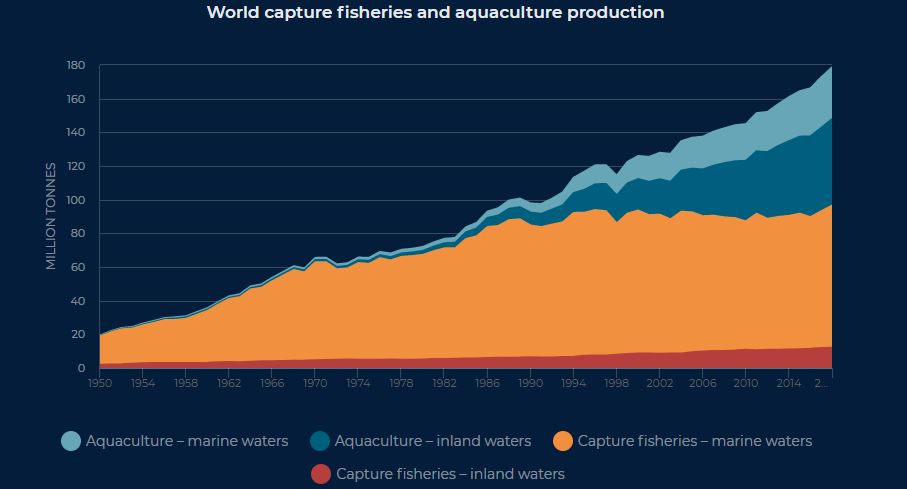
Figure 1. SOFIA report 2020 © FAO
In mid 2020, the Food and Agriculture Organization of the United Nations (FAO) published its report “The State of World Fisheries and Aquaculture 2020,” known as SOFIA 2020[1]. This report, produced every two years, is especially significant this year due to the global coronavirus pandemic, which has focussed minds not only on food production supply chains but also on the relationship between human and environmental health.
Focus on sustainability
The report has a particular focus on sustainability and is subtitled “Sustainability in Action” with reference to the continued growth of fisheries and aquaculture (Figure 1). In particular the report details progress towards the United Nations 2030 Agenda for Sustainable Development, launched in 2015. 2020 also sees the 25th anniversary of the FAO’s Code of Conduct for Responsible Fisheries, intended to provide an “overarching framework for international, regional and national efforts to sustainably and responsibly utilize fisheries and aquaculture resources”.[2]
The first section of the report deals with current levels of fish production globally, which is predicted to increase from 2018 levels of 179 million metric tons (MT) to around 204 million MT by 2030. Of the overall total, 156 million MT were used for human consumption, equivalent to 20.5 kg per person per year.
The focus on sustainability is particularly important to aquaculture, which accounts for 46% of the total production and 52% of fish intended for human consumption. It grew at an annual average of 5.3% between 2001 and 2018, reaching an all-time record high production in 2018.
Aquaculture growth will continue
SOFIA anticipates that aquaculture will continue to be drive the growth in global fish production, by accounting for 109 million MT in 2030, an increase of 32 percent or 26 million MT from 2018. However the average annual growth rate of aquaculture should slow to 2.3 percent for 2019–2030. The report suggests this will be as a result of:
- tougher environmental regulations;
- reduced water availability and suitable production locations;
- increased outbreaks of aquatic animal diseases;
- decreasing aquaculture productivity gains.

Figure 2. World capture fisheries and aquaculture production. FAO (2020) SOFIA report.
The report highlights new fisheries and aquaculture reforms and policies being implemented by China, the world’s leading fish producer. It has been the main exporter of fish products for almost two decades, and for the last decade has been the third-ranked importing country in terms of value. Continuation of its Thirteenth Five-Year Plan (2016–2020) will slow the country’s fisheries and aquaculture growth, resulting in higher prices in China, and around the world.
Increased demand for seafood and slowing growth of fisheries and aquaculture production will see prices increase by almost a quarter in the next 10 years. Overall, farmed fish prices will climb 24 percent by 2030, while wild-capture fish will increase by 23 percent, with the FAO explaining that on the demand side, factors influencing this trend will include improved income, population growth, and higher meat prices. On the supply side, stable capture fisheries production, slowing growth in aquaculture production, and cost increase for inputs such as feed, energy, and oil are likely to play a role. Indeed, it forecasts that fishmeal and fish oil prices will increase by 30 percent and 13 percent, respectively, in nominal terms by 2030, as a result of strong global demand.
FAO Code of Conduct for Responsible Fisheries
The FAO’s Code is intended to shape policy and sustainability principles globally by highlighting environmental and conservation concerns of both wild capture fisheries and aquaculture. It calls for both industries to acknowledge intrinsic issues such as:
- ocean degradation;
- biodiversity;
- climate change;
- social responsibility.
2020 is also the 75th anniversary of the formation of the Food and Agriculture Organization, and therefore a reason, according to FAO Director-General Qu Dongyu, for “calls to action, springboards for change, for a rapidly changing world in need of innovative and transformative solutions to old as well as new problems”.[3]
Transparency is key
In order to ensure both wild capture fisheries and aquaculture are performing sustainably, both industries need to enable full and detailed examination of their practices and supply chains. This will enable rigorous regulation, and where regulation is lacking or weak will enable all parts of the supply chain such as processors, retailers and consumers to be selective of products that clearly show they have been produced in a sustainable manner. While ‘sustainable’ can have varying definitions, in environmental terms it should at the very least encompass the issues outlined in the FAO’s Code of Conduct for Responsible Fisheries. Thus to be environmentally sustainable, fisheries and aquaculture must not result in no ocean degradation, and must operate with minimal impact on biodiversity and climate change.
Transparency is especially key to ensure practices used in the aquaculture industry are not impacting the environment, and Fidra is calling for improvements to the flow on information in the salmon farming industry in Scotland. A sustainability dashboard or similar database with clear and accessible information is therefore called for, as outlined in a previous blog on this site.
[1] http://www.fao.org/publications/sofia/2020/en/#:~:text=The%20State%20of%20World%20Fisheries%20and%20Aquaculture%20%28SOFIA%29,capture%20fisheries%20and%20aquaculture%2C%20including%20associated%20policy%20issue.
[2] http://www.fao.org/3/ca9229en/online/ca9229en.html#chapter-2_1
[3] http://www.fao.org/3/ca9231en/CA9231EN.pdf
Tags: aquaculture, FAO, salmon farming, Scotland, sustainability dashboard

